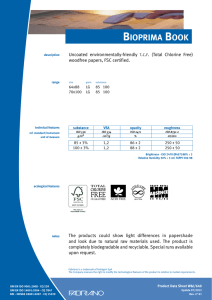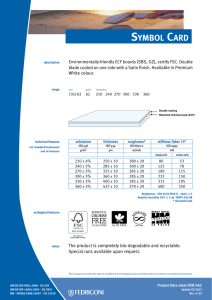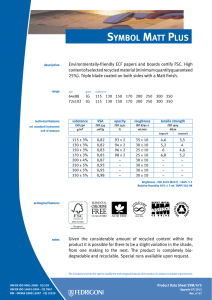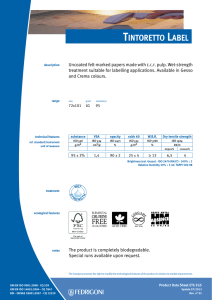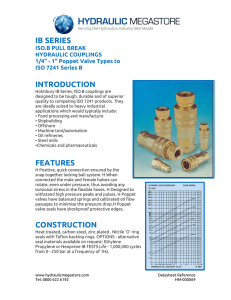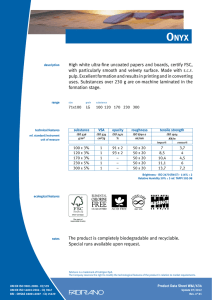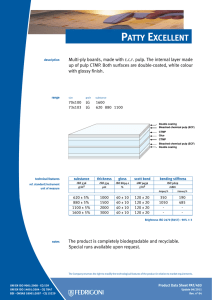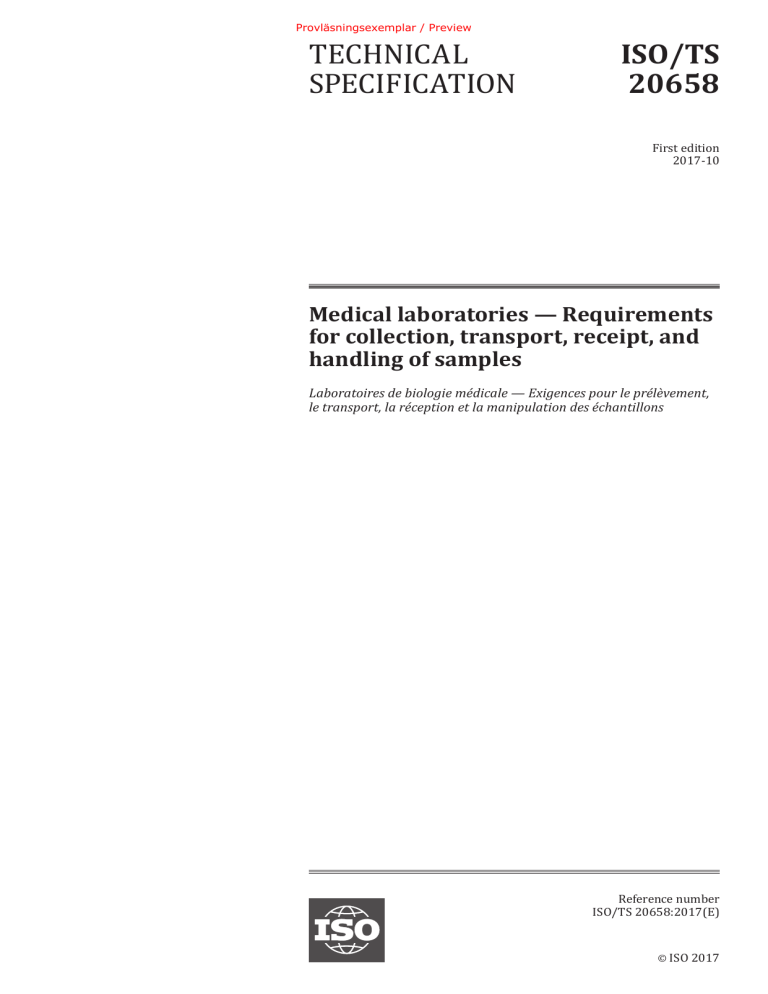
Provläsningsexemplar / Preview TECHNICAL SPECIFICATION ISO/TS 20658 First edition 2017-10 Medical laboratories — Requirements for collection, transport, receipt, and handling of samples Laboratoires de biologie médicale — Exigences pour le prélèvement, le transport, la réception et la manipulation des échantillons Reference number ISO/TS 20658:2017(E) © ISO 2017 Provläsningsexemplar / Preview ISO/TS 20658:2017(E) COPYRIGHT PROTECTED DOCUMENT © ISO 2017, Published in Switzerland All rights reserved. Unless otherwise specified, no part of this publication may be reproduced or utilized otherwise in any form or by any means, electronic or mechanical, including photocopying, or posting on the internet or an intranet, without prior written permission. Permission can be requested from either ISO at the address below or ISO’s member body in the country of the requester. ISO copyright office Ch. de Blandonnet 8 • CP 401 CH-1214 Vernier, Geneva, Switzerland Tel. +41 22 749 01 11 Fax +41 22 749 09 47 [email protected] www.iso.org ii © ISO 2017 – All rights reserved Provläsningsexemplar / Preview ISO/TS 20658:2017(E) Contents Page Foreword......................................................................................................................................................................................................................................... vi Introduction............................................................................................................................................................................................................................... vii 1 2 3 4 5 6 7 8 9 Scope.................................................................................................................................................................................................................................. 1 Normative references....................................................................................................................................................................................... 1 Terms and definitions...................................................................................................................................................................................... 1 Quality management......................................................................................................................................................................................... 3 Pre-examination processes relating to patient samples............................................................................................. 4 5.1 General............................................................................................................................................................................................................ 4 5.2 Laboratory test is ordered............................................................................................................................................................. 5 5.3 Sample request generation process....................................................................................................................................... 5 5.4 Process for providing instructions to patients............................................................................................................. 5 5.5 Patient identification process..................................................................................................................................................... 5 5.6 Preparation for sample collection process...................................................................................................................... 5 5.7 Primary sample collection and labelling process...................................................................................................... 5 5.8 Preparation for transportation process............................................................................................................................. 5 5.9 Sample transport process............................................................................................................................................................... 5 5.10 Sample receipt process..................................................................................................................................................................... 5 5.11 Process for preparing sample for examination............................................................................................................ 5 Infrastructure and environmental conditions....................................................................................................................... 6 6.1 General............................................................................................................................................................................................................ 6 6.2 Design.............................................................................................................................................................................................................. 6 6.2.1 General...................................................................................................................................................................................... 6 6.2.2 Safety and accessibility............................................................................................................................................... 6 6.2.3 Privacy and confidentiality...................................................................................................................................... 7 6.2.4 Equipment, supplies and storage....................................................................................................................... 7 6.3 Facility maintenance and environmental conditions............................................................................................. 7 6.4 Personnel facilities............................................................................................................................................................................... 7 Equipment and supplies................................................................................................................................................................................ 7 7.1 General............................................................................................................................................................................................................ 7 7.2 Equipment acceptance testing................................................................................................................................................... 7 7.3 Inspection and storage...................................................................................................................................................................... 8 7.4 Inventory management.................................................................................................................................................................... 8 7.5 Equipment maintenance and repair...................................................................................................................................... 8 7.6 Equipment operation......................................................................................................................................................................... 8 7.7 Computer equipment......................................................................................................................................................................... 9 7.8 Equipment records............................................................................................................................................................................... 9 Infection prevention and control (biosafety).......................................................................................................................10 8.1 Personal protective equipment.............................................................................................................................................. 10 8.2 Hand hygiene.......................................................................................................................................................................................... 10 8.3 Personnel practices........................................................................................................................................................................... 10 8.4 Safe disposal............................................................................................................................................................................................ 10 8.5 Patient protection............................................................................................................................................................................... 11 8.6 Cleaning and disinfection............................................................................................................................................................. 11 8.7 Special precautions........................................................................................................................................................................... 11 Personnel................................................................................................................................................................................................................... 11 9.1 General......................................................................................................................................................................................................... 11 9.2 Training and competence............................................................................................................................................................ 11 9.2.1 Personnel training........................................................................................................................................................ 11 9.2.2 Competence and continuing education...................................................................................................... 12 9.3 Confidentiality and access to information.................................................................................................................... 12 9.4 Personnel records.............................................................................................................................................................................. 12 © ISO 2017 – All rights reserved iii Provläsningsexemplar / Preview ISO/TS 20658:2017(E) 10 11 12 13 14 15 16 17 18 19 20 21 22 iv Information for patients and users of services..................................................................................................................13 10.1 Information to be provided by laboratories that will receive the samples....................................... 13 10.2 Information for patients............................................................................................................................................................... 14 Request form..........................................................................................................................................................................................................15 11.1 Request form information........................................................................................................................................................... 15 11.2 Verbal requests..................................................................................................................................................................................... 16 11.3 Transcription.......................................................................................................................................................................................... 16 Patient identification.....................................................................................................................................................................................16 12.1 General......................................................................................................................................................................................................... 16 12.2 Routine patient identification.................................................................................................................................................. 16 12.3 Patient identification in medical emergency situations.................................................................................... 17 12.4 Patient identification of babies and young children............................................................................................. 17 Identification of samples...........................................................................................................................................................................17 Sample collection...............................................................................................................................................................................................18 14.1 General......................................................................................................................................................................................................... 18 14.2 Informed consent................................................................................................................................................................................ 18 14.3 Instructions for collection activities................................................................................................................................... 19 14.4 Handling urgent requests............................................................................................................................................................ 19 14.5 Blood sample collection................................................................................................................................................................ 19 14.5.1 General................................................................................................................................................................................... 19 14.5.2 Order of draw................................................................................................................................................................... 20 14.5.3 Special considerations when performing venipuncture............................................................. 20 14.5.4 Adult capillary puncture......................................................................................................................................... 20 14.5.5 Paediatric venipuncture.......................................................................................................................................... 21 14.5.6 Paediatric capillary puncture.............................................................................................................................. 21 14.6 Other samples........................................................................................................................................................................................ 22 Sample integrity and stability..............................................................................................................................................................22 15.1 Sample integrity................................................................................................................................................................................... 22 15.2 Stability........................................................................................................................................................................................................ 23 15.3 Stabilization............................................................................................................................................................................................. 23 Transport of samples.....................................................................................................................................................................................23 16.1 General......................................................................................................................................................................................................... 23 16.2 Sample transport................................................................................................................................................................................. 24 16.3 Quality monitoring............................................................................................................................................................................ 24 Sample receipt and assessment..........................................................................................................................................................24 17.1 General......................................................................................................................................................................................................... 24 17.2 Criteria for sample acceptance or rejection................................................................................................................. 24 17.3 Sample label confirmation.......................................................................................................................................................... 25 17.3.1 General................................................................................................................................................................................... 25 17.3.2 Managing nonconformities................................................................................................................................... 25 17.4 Records of sample receipt........................................................................................................................................................... 26 17.5 Sample tracking.................................................................................................................................................................................... 26 17.6 Urgent samples..................................................................................................................................................................................... 26 17.7 Chain of Custody.................................................................................................................................................................................. 26 Sample storage prior to examination...........................................................................................................................................26 Customer satisfaction....................................................................................................................................................................................27 Identification and control of nonconformities...................................................................................................................27 20.1 Identification of nonconformities......................................................................................................................................... 27 20.2 Records of nonconformities...................................................................................................................................................... 27 Performance indicators..............................................................................................................................................................................28 Documents and records..............................................................................................................................................................................28 22.1 General......................................................................................................................................................................................................... 28 © ISO 2017 – All rights reserved Provläsningsexemplar / Preview ISO/TS 20658:2017(E) 22.2 22.3 Documents................................................................................................................................................................................................ 29 Records........................................................................................................................................................................................................ 29 Annex A (informative) Your five moments for hand hygiene....................................................................................................30 Annex B (informative) Disinfectants..................................................................................................................................................................31 Bibliography.............................................................................................................................................................................................................................. 33 © ISO 2017 – All rights reserved v Provläsningsexemplar / Preview ISO/TS 20658:2017(E) Foreword ISO (the International Organization for Standardization) is a worldwide federation of national standards bodies (ISO member bodies). The work of preparing International Standards is normally carried out through ISO technical committees. Each member body interested in a subject for which a technical committee has been established has the right to be represented on that committee. International organizations, governmental and non-governmental, in liaison with ISO, also take part in the work. ISO collaborates closely with the International Electrotechnical Commission (IEC) on all matters of electrotechnical standardization. The procedures used to develop this document and those intended for its further maintenance are described in the ISO/IEC Directives, Part 1. In particular, the different approval criteria needed for the different types of ISO documents should be noted. This document was drafted in accordance with the editorial rules of the ISO/IEC Directives, Part 2 (see www.iso.org/directives). Attention is drawn to the possibility that some of the elements of this document may be the subject of patent rights. ISO shall not be held responsible for identifying any or all such patent rights. Details of any patent rights identified during the development of the document will be in the Introduction and/or on the ISO list of patent declarations received (see www.iso.org/patents). Any trade name used in this document is information given for the convenience of users and does not constitute an endorsement. For an explanation on the voluntary nature of standards, the meaning of ISO specific terms and expressions related to conformity assessment, as well as information about ISO's adherence to the World Trade Organization (WTO) principles in the Technical Barriers to Trade (TBT), see the following URL: www.iso.org/iso/foreword.html. This document was prepared by Technical Committee ISO/TC 212, Clinical Laboratory testing and in vitro diagnostic test systems. vi © ISO 2017 – All rights reserved Provläsningsexemplar / Preview ISO/TS 20658:2017(E) Introduction Medical laboratory services are essential to patient care and public health and therefore, have to be available to meet the needs of all patients and the clinical personnel responsible for the care of those patients. Such services are required to be performed according to documented policies and procedures for examination requests, patient preparation, patient identification, collection of samples, transportation of samples, sample storage, processing, examination of samples and reporting results, in addition to the considerations of safety and ethics in medical laboratory work. This document provides guidance from a number of sources that are incorporated into a set of good laboratory practices encompassing the pre-examination processes, in a way that meets published requirements for sample collection and handling. This document is intended to be used by individuals and organizations engaged in the collection of samples for submission to medical laboratories for examination, for the purpose of ensuring the quality of laboratory services and to achieve better health outcomes for the public. It is acknowledged that a country could have its own specific guidance or requirements applicable to professional personnel, their activities and their responsibilities in this domain. Each laboratory or sample collection organization should determine its level of adherence to the good laboratory practices described in this document. Management should take the first step by setting appropriate priorities based on patient and customer needs, the resources available, as well as local, regional and national mandates. This document was developed based on the Canadian Standard CSA Z316.7−12. © ISO 2017 – All rights reserved vii Provläsningsexemplar / Preview Provläsningsexemplar / Preview TECHNICAL SPECIFICATION ISO/TS 20658:2017(E) Medical laboratories — Requirements for collection, transport, receipt, and handling of samples 1 Scope This document specifies requirements and good practice recommendations for the collection, transport, receipt and handling of samples intended for medical laboratory examinations. This document is applicable to medical laboratories and other medical services involved in laboratory pre-examination processes that include the examination request, patient preparation and identification, sample collection, transport, receipt and storage. It may also be applicable to some biobanks. This document does not apply to blood and blood products intended for transfusion. 2 Normative references There are no normative references in this document. 3 Terms and definitions 3.1 arterial puncture procedure (3.13) that involves the collection of blood from arteries by puncturing the skin 3.2 biobank entity that performs biobanking (3.3) Note 1 to entry: A biobank encompasses staff, facilities and procedures (e.g. management systems) and includes service providers, as well as repositories of biological materials. 3.3 biobanking process (3.14) of receiving, collecting, storing and distributing biological materials from human, animal, plant and microorganisms, as well as related information and data, for the purpose of research and development Note 1 to entry: Some or all of the following activities may also be included: processing, testing and analysing. Note 2 to entry: For the purpose of this document, this definition only includes human materials procured solely for diagnostic and treatment purposes, e.g. surgical pathology archives. 3.4 capillary puncture procedure (3.13) that involves the collection of blood from capillaries by puncturing the skin 3.5 cleaning process (3.14) to remove any type of contamination, visible or not [SOURCE: ISO 15190:2003, 3.5] © ISO 2017 – All rights reserved 1 Provläsningsexemplar / Preview ISO/TS 20658:2017(E) 3.6 decontamination procedure (3.13) that eliminates or reduces microbial or toxic agents to a safe level with respect to the transmission of infection or other adverse effects [SOURCE: ISO 15190:2003, 3.7] 3.7 disinfection process (3.14) of reducing the number of microorganisms, but not usually bacterial spores, without necessarily killing or removing all organisms [SOURCE: ISO 15190:2003, 3.9] 3.8 examination processes analytical phase set of operations having the object of determining the value or characteristics of a property Note 1 to entry: Laboratory examinations are also often called assays or tests. [SOURCE: ISO 15189:2012, 3.7, modified — Notes to entry 2 and 3 have been omitted.] 3.9 hand hygiene general term referring to any action of hand cleansing [SOURCE: WHO Guidelines on Hand Hygiene in Health Care, 2009] 3.10 medical laboratory clinical laboratory laboratory for the biological, microbiological, immunological, chemical, immunohaematological, haematological, biophysical, cytological, pathological, genetic or other examination of materials derived from the human body for the purpose of providing information for the diagnosis, management, prevention and treatment of disease in, or assessment of the health of, human beings, and which may provide a consultant advisory service covering all aspects of laboratory investigation including the interpretation of results and advice on further appropriate investigation Note 1 to entry: These examinations also include procedures for determining, measuring or otherwise describing the presence or absence of various substances or microorganisms. [SOURCE: ISO 15189:2012, 3.11] 3.11 post-examination processes post-analytical phase processes (3.14) following the examination, including review of results, retention and storage of clinical material, sample and waste disposal, as well as formatting, releasing, reporting and retention of examination results [SOURCE: ISO 15189:2012, 3.14] 3.12 pre-examination processes pre-analytical phase processes (3.14) that start, in chronological order, from the clinician’s request and include the examination request, preparation and identification of the patient, collection of the primary sample(s) and transportation to and within the laboratory and end when the analytical examination begins [SOURCE: ISO 15189:2012, 3.15] 2 © ISO 2017 – All rights reserved Provläsningsexemplar / Preview ISO/TS 20658:2017(E) 3.13 procedure specified way to carry out an activity or a process (3.14) [SOURCE: ISO 9000:2015, 3.4.5] 3.14 process set of interrelated or interacting activities that use inputs to deliver an intended result Note 1 to entry: Inputs to a process are generally outputs of other processes and outputs of a process are generally the inputs to other processes. [SOURCE: ISO 9000:2015, 3.4.1] 3.15 personal protective equipment materials used to form a barrier to prevent contamination of a person by chemical or biological substances Note 1 to entry: This includes, but is not limited to, lab coats, gowns, gloves, face shields and goggles. 3.16 sample primary sample discrete portion of a body fluid, breath, hair or tissue taken for examination, study or analysis of one or more quantities or properties assumed to apply for the whole Note 1 to entry: Global Harmonization Task Force (GHTF) uses the term specimen in its harmonized guidance documents to mean a sample of biological origin intended for examination by a medical laboratory. Note 2 to entry: In some ISO and CEN documents, a specimen is defined as “a biological sample derived from the human body.” Note 3 to entry: In some countries, the term “specimen” is used instead of primary sample (or a subsample of it), which is the sample prepared for sending to, or as received by, the laboratory and which is intended for examination. Note 4 to entry: The term “sample” is used in this document to include both the primary sample (specimen) and sample (aliquot). [SOURCE: ISO 15189:2012, 3.16, modified — Note 4 to entry has been added.] 3.17 sample collection process of obtaining a primary sample (3.16) 3.18 venipuncture procedure (3.13) that involves the collection of venous blood by penetrating a vein with a needle or other collection apparatus 4 Quality management An organization engaged in collecting, handling and submitting samples for examinations by medical laboratories, should establish, document, implement and maintain a system, to enhance customer satisfaction through assurance of conformity to customer needs, fulfil applicable statutory and regulatory requirements and include processes to improve the system. Having a quality management system in place will facilitate the implementation of these requirements. © ISO 2017 – All rights reserved 3

